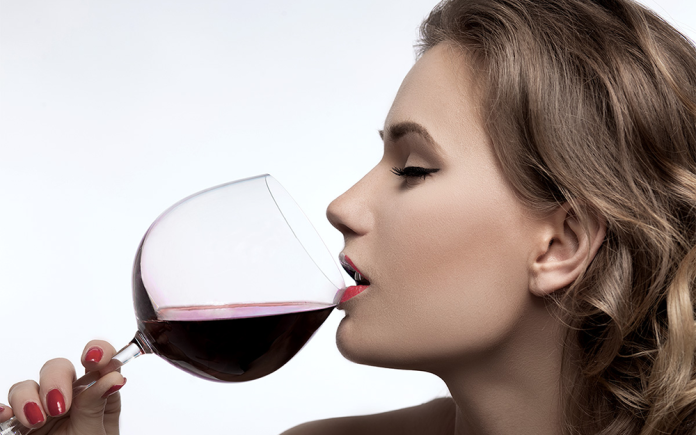
By Rick Riozza
And just like that! February’s Valentine’s Day is just around the corner.
For those of you still “drying out” in January, and for some reason or another, wish to continue the practice, we thought it would be the right thing to do to list a few very romantic wines to serve at St. Valentine’s Day—sans alcool i.e., without alcohol!
At first glance, the traditional mind may inquire as to why. Well—as we’ve mentioned ad infinitum, it’s a brave new wine world out there, with a lot of new players in the game of wine. On the up-side to N/A—alcohol free wines, there are no added headaches, no added bad or reckless behaviors, no DUIs, and perhaps, no additional performance issues. Enough said.
The next concern is how good is this stuff to give us a true “wine experience”? Hilary Sheinbaum, author of the best-selling book: The Dry Challenge says, “Excellent flavor needn’t be sacrificed when looking for a well-made alternative, and industry professionals agree. “A great N/A wine tastes like the full-proof version, just without a buzz,” Sheinbaum notes that out of all alcohol categories, wine can be the hardest non-alcoholic beverage to replicate, particularly with regard to body and structure. “That said, there are some brands who do N/A wines really well,”
Liquor.com tells us: “Many consumers think that non-alcoholic wine is simply unfermented grape juice, but the true high-quality bottles are actually made with the same processes that are used for regular wine. “Yeasts and the vinification process are the biggest difference between alcohol-free wine and grape juice,” explains Thierry Cowez, oenologist and dealcoholized winemaker for MIS Services in Belgium. According to Cowez, true non-alcoholic or dealcoholized wine is produced from wine that has been fermented with yeasts and has undergone a vinification process; the alcohol is then removed through processes such as reverse osmosis or vaccum distillation.
“Once you remove the alcohol, the beverage reminds you of wine, although it doesn’t taste exactly like it”. Dealcoholized wines are then generally ‘rebuilt’ with natural flavors and oenological products to replicate the elements lost during distillation.
Dealcoholized wine thus delivers a full spectrum of flavors that can only be achieved through fermentation and vinification. Other fruit-based products marketed as non-alcoholic wine are simply juice. Note however: there’s currently no legal difference between dealcoholized wines (true non-alcoholic wines) and grape juice, which can cause confusion for consumers.
Okay—as a rabbi perhaps may ask: “So what makes a romantic wine?” Well—we guess a fair answer is simply “a romantic date night wine”: a red, white, pink champagne or rosé. Easy enough. And believe it or not, in the past two, three years—the alcohol-free wine business has boomed!
So here are a few N/A “romantic” wines capable of fulfilling the evening or evenings of love.
St. Regis Nonalcoholic Shiraz Rosé ($10) Pretty in pink for certain and a perfect “romantic wine” this really inexpensive N/A rosé is the cheap ticket to one’s heart with red currants, raspberries, and citrus notes. The acidity is worth the price alone—and that makes it a very good food wine. More of an appetizer type wine, it also will pair well with smoked ham and melon, crab cakes, or fried shell fish.
Another inexpensive bubbly—albeit brut, is the Freixenet Mousseux Cuvée sans alcool ($10) (but hey! If you wish to pink it up for Valentines—just simply add/blend a dollop of a nice red wine you’ve got on your table.) When it comes to a N/A bubbly that comes close to the real thing—this is the buy!
The cuvée was first launched in 2011, after two years of winemaking trials and extensive market research. The wine’s bubbly palate is loaded with flavors of ripe citrus, tropical fruits, and lemon zest. Persistent mousse and well-balanced residual sugar lead to a vibrant finish.
The company’s labor-intensive techniques are used during the alcohol removal process to ensure that fruit-forward flavors and freshness are not sacrificed.
For those “savvy blanc” lovers, look no further than to the Giesen Sauvignon Blanc Dealcoholized ($12). To be honest, the flavor profile actually mirrors the regular Giesen Sauv blanc wine, that shows fruity and refreshing notes of: green apple, citrus, tropical fruits, and hints of stone fruits.
Now to the Giesen Non-Alcoholic Rosé ($12). It is a blend of Pinot Grigio, Syrah, and Pinot Noir. harvested from Marlborough, giving this rosé its lovely pink hue. The finished wine undergoes a gentle spinning process to dealcoholize the wine without sacrificing the optimal crispness and bountiful aromas.
The Giesen website states: “Full of various red and stone fruit flavors, this classic expression of rosé is clean, crisp, and refreshing; the interplay of flavors and a dry texture gives it a pick-me-up feeling. Serve it chilled in a long-stem wine glass and you have a picturesque pour for any guests abstaining from alcohol. Or, bring it along as a hostess gift!”
For Chardonnay lovers, look to Luminara Chardonnay Napa Non-Alcoholic Wine ($16). This wine offers flavors of green apple, tropical fruit, and lemon cream. Aging the wine in both French and American oak provides hints of sweet baking spice, which leads to a long and luminous finish. Serve with cheese boards, seared scallops, or poultry-based dishes.
And finally for a red: An inexpensive red blend non-alcoholic wine is the FRE Red Blend ($9) Of all of the FRE brands, this is one of the best for a real wine feel and flavor. It shows dark fruits that one expects for a red blend wine. Simple enough and inexpensive enough.
For a more in-depth red wine, look to 2019 Solo Garnarcha ($35) from Studio Null—a company that produces really good non-alcoholic wines. Here, you’ll find all of the traditional flavors of your favorite French or Spanish Grenache wine.
Here’s to romance! Cheers!










































